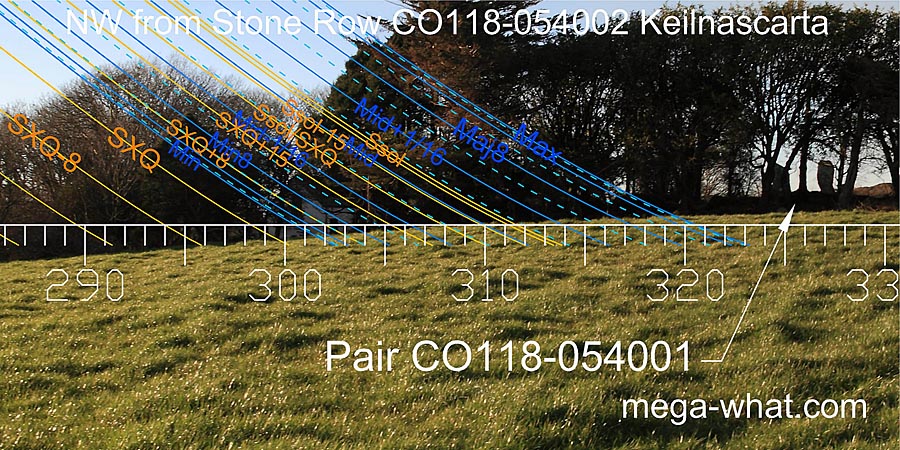 Keilnascarta Stone Row is south of Bantry, about 3km as the crow flies, 5km by road. A low three-stone row, its largest stone is to the west, smallest east and tallest (just) in the middle.
The stones are aligned point-to-point rather than face-to-face.
Keilnascarta Stone Row is south of Bantry, about 3km as the crow flies, 5km by road. A low three-stone row, its largest stone is to the west, smallest east and tallest (just) in the middle.
The stones are aligned point-to-point rather than face-to-face.It is accompanied by two Standing Stone Pairs. CO118-054001 is 60m to the north and visible in this picture. CO118-054003 is 90m to the south, on the other side of an old railway cutting.
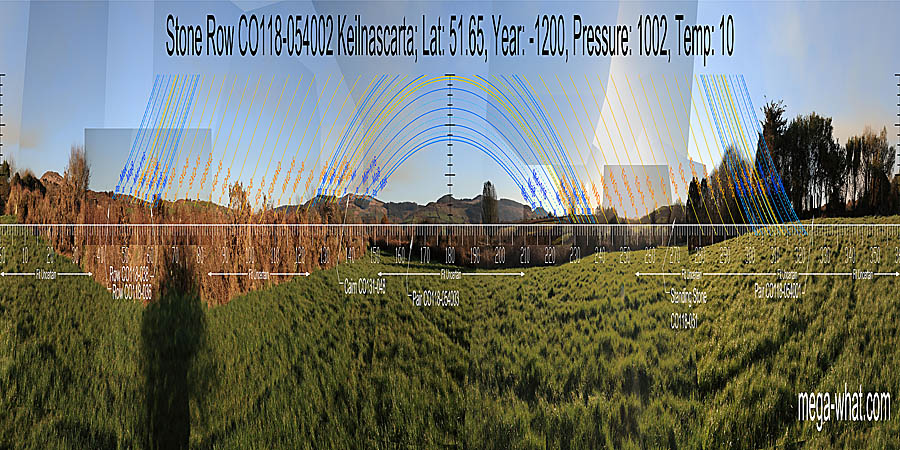 South is marked by a hilltop [Pic].
South is marked by a hilltop [Pic].
North is somewhere on a slope but obscured [Pic].
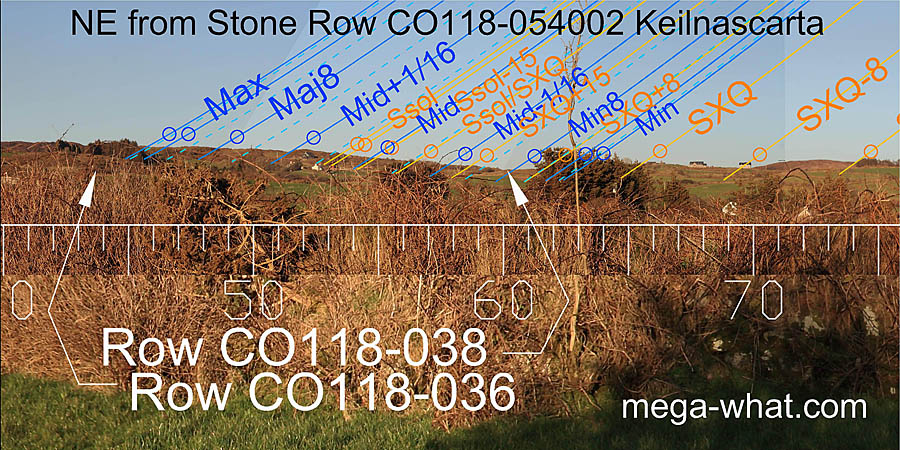 To the north-east, the cross-quarter is on a hilltop with the lunar minor eighth in the saddle at its north base.
The remainder of the summer sunrises and lunar nodal cycle run up the slope, terminating with the major standstillLunistice positions vary cyclically over an 18.6 year period but are fairly static for more than a year at either end of the range
at a dip/notch created by the intersect of the ridge with a more distant hill.
To the north-east, the cross-quarter is on a hilltop with the lunar minor eighth in the saddle at its north base.
The remainder of the summer sunrises and lunar nodal cycle run up the slope, terminating with the major standstillLunistice positions vary cyclically over an 18.6 year period but are fairly static for more than a year at either end of the range
at a dip/notch created by the intersect of the ridge with a more distant hill.
The row axis indicates the saddle which marks the lunar minor eighth [Pic] though Ruggles made no axial determination in this direction. This saddle is also the site of Dereengreanagh Stone Row
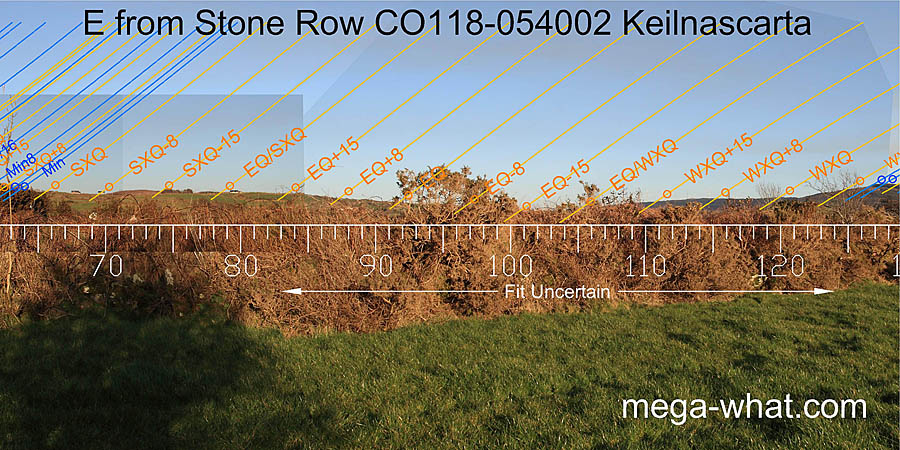 The central part of the eastern horizon has not been surveyed but it looks as if the main dip is a half-month south of the equinox.
The central part of the eastern horizon has not been surveyed but it looks as if the main dip is a half-month south of the equinox.
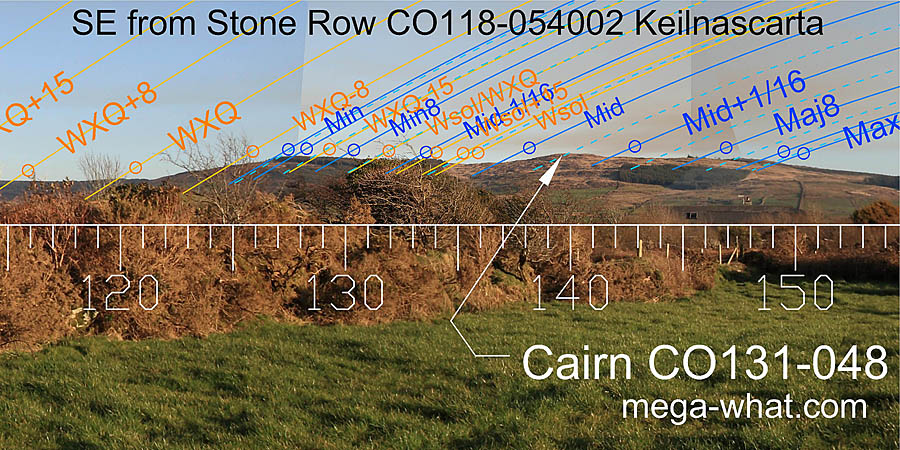 To the south-east, the cross-quarter is on a hilltop and lunar minor standstillLunistice positions vary cyclically over an 18.6 year period but are fairly static for more than a year at either end of the range
is on a nearer one, then the solstice is in a dip.
The lunar midpoint and its following sixteenth are at the north and south basal steps of the top that has Letterlicky Cairn on it.
The major eighth is on the next top and major standstillLunistice positions vary cyclically over an 18.6 year period but are fairly static for more than a year at either end of the range
is at the south basal step of the last top before a large saddle.
To the south-east, the cross-quarter is on a hilltop and lunar minor standstillLunistice positions vary cyclically over an 18.6 year period but are fairly static for more than a year at either end of the range
is on a nearer one, then the solstice is in a dip.
The lunar midpoint and its following sixteenth are at the north and south basal steps of the top that has Letterlicky Cairn on it.
The major eighth is on the next top and major standstillLunistice positions vary cyclically over an 18.6 year period but are fairly static for more than a year at either end of the range
is at the south basal step of the last top before a large saddle.
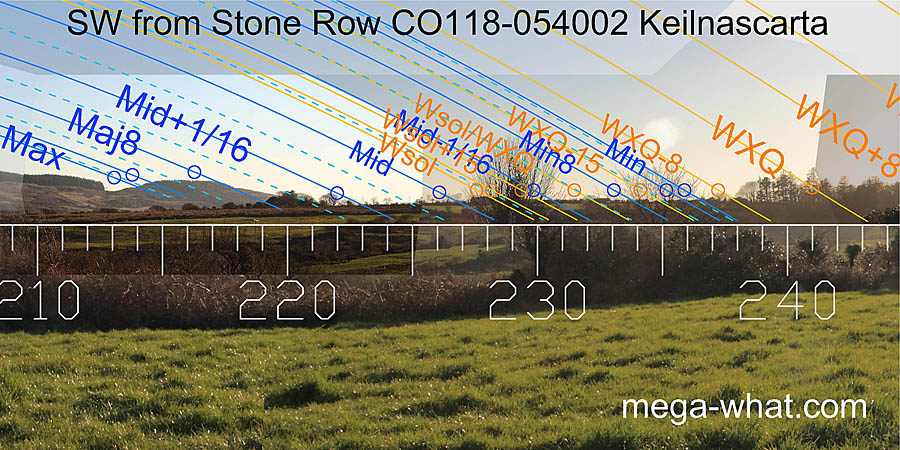 At the western end of the south ridge is a hill which nicely marks out moonsets of the major end of the lunisticeLunistices are the most northerly and southerly moons of the month. The lunar equivalent of solstices - more.
range. Then the horizon becomes fairly local and featureless.
At the western end of the south ridge is a hill which nicely marks out moonsets of the major end of the lunisticeLunistices are the most northerly and southerly moons of the month. The lunar equivalent of solstices - more.
range. Then the horizon becomes fairly local and featureless.
The row's axis [Pic] indicates the minor end of the lunisticeLunistices are the most northerly and southerly moons of the month. The lunar equivalent of solstices - more. range in this direction which may be on the local hilltop but that area is now obscured by trees and farm buildings.
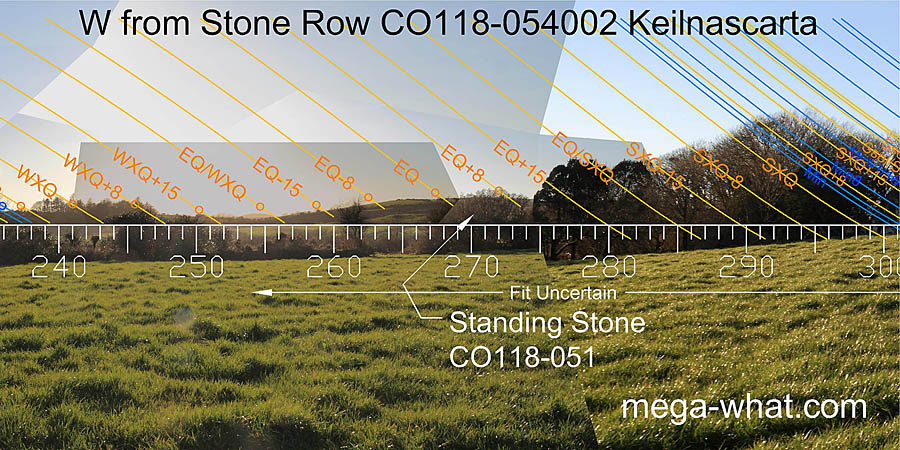 Westwards some hilltops of the Muintirvara peninsula may be seen through a saddle.
The southern intersect of these near and far horizons is a half-month north of the winter cross-quarter.
It looks as if the next intersect marks the cross-quarter / equinox midpoint with the equinox on top of the hill but beyond that remains unsurveyed.
Westwards some hilltops of the Muintirvara peninsula may be seen through a saddle.
The southern intersect of these near and far horizons is a half-month north of the winter cross-quarter.
It looks as if the next intersect marks the cross-quarter / equinox midpoint with the equinox on top of the hill but beyond that remains unsurveyed.
Whether or not this row and the adjacent stone pairs were originally conceived as a unit, they do seem to be members of series. There is another row 1.36km south of this one at Maulinward and the first one to the north-east is 1.16km away at Scartbaun. The other pairs are between here and the head of Dunmanus Bay, the nearest being c.900m to the south-south-east at Parkana.
Roughly 700m due west, Gortacloona Standing Stone, now fallen, would be intervisible with this stone row and both pairs and all with each other, but for vegetation. Known to be missing from the general area are 6 Standing Stones on 3 sites: CO118-037, CO118-052 and CO118-055.
References
- Archaeological Survey of Ireland, record details. www.archaeology.ie/archaeological-survey-ireland
- Ó'NUALLÁIN, SEÁN 1988 Stone Rows in the South of Ireland. Proceedings of the Royal Irish Academy 88c:179-256, p236, no.48.
- POWER, D. et al. 1992 Archaeological Inventory of County Cork, Volume 1: West Cork. Dublin: Stationary Office. p36, no.154.
- RUGGLES, C.L.N. 1999 Astronomy in Prehistoric Britain and Ireland. Newhaven & London: Yale University Press. CKR81.
- RUGGLES, C.L.N. 1996 Stone Rows of Three or More Stones in South-West Ireland. Archaeoastronomy 21 (Journal of the History of Astronomy xxvii) S55-S71.
- RUGGLES, C.L.N. & Burl, H.A.W. 1995 Astronomical Influences on Prehistoric Ritual Architecture in North-Western Europe: The Case of the Stone Rows. Vistas in Astronomy 39:517-528. Oxford: Elsevier Science Ltd.

